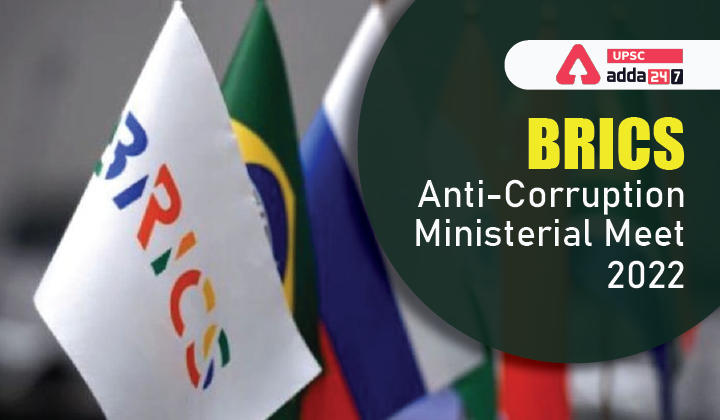Table of Contents
BRICS Anti-Corruption Ministerial Meet- Relevance for UPSC Exam
- GS Paper 2: International Relations- Bilateral, regional and global groupings and agreements involving India and/or affecting India’s interests.
BRICS Anti-Corruption Ministerial Meet in News
- Recently, the Union Minister Dr. Jitendra Singh addressed the BRICS Anti-Corruption Ministerial Meet 2022.
- He reiterates India’s commitment against corruption as India has adopted a policy of zero tolerance in this regard.
- Central Vigilance Commission in India is the nodal agency entrusted with the task of overseeing preventive and punitive measures.
BRICS Anti-Corruption Ministerial Meet
- About: On July 13, the first BRICS ministerial meeting on anti-corruption was held by video conference under the chairmanship of China.
- Outcome: Communiqué of the BRICS Ministerial Meeting on Anti-Corruption was signed.
- All BRICS Member parties reached broad consensus on rejecting the corruption safe haven initiative, showing to the international community a clear stance of safeguarding fairness and justice with practical actions.
- Participation: Heads of BRICS anti-corruption agencies and UNODC and other international organizations attended the BRICS Anti-Corruption Ministerial.
Steps taken by India to Reduce Corruption
- Prevention of Corruption (Amendment) Act, 2018: to introduce a number of new provisions including-
- Criminalizing the act of giving bribe also in addition to taking bribe and
- At the same time putting in place an effective deterrence for such actions by individuals as well as corporate entities.
- Operationalization of Lokpal: Lokpal is statutorily mandated to directly receive and process complaints as regards alleged offences against public servants under the Prevention of Corruption Act,1988.
- E-governance measures to reduce Corruption: effective implementation of e-Governance through extensive use of ICT tools which has reduced the scope of corruption substantially at all levels. For example-
- MCA21 (for corporates & business houses e-measures),
- Fully automated Income Tax compliances,
- Commercial taxes compliances,
- Passport & Visa services,
- Digi Locker,
- Pensions,
- Direct Benefit Transfers (DBT) through Aadhaar Payment Bridge (APB),
- Common Services Centres (CSCs), etc.
- National e-Governance Services Delivery Assessment (NeSDA) framework: It assesses the effectiveness / quality of the e-Governance service delivery mechanism from the citizen’s perspective.
- It was conceptualized and launched in August 2018.
About BRICS Grouping
- About: BRICS is an acronym for the grouping of the world’s leading emerging economies, namely Brazil, Russia, India, China, and South Africa.
- Background: In 2001, Goldman Sachs’ Jim O’Neill authored a paper called “Building Better Global Economic BRICs”, pointing out that future GDP growth in the world would come from China, India, Russia, and Brazil.
- Though the paper did not recommend any formal grouping, it said that BRIC economies combined would outstrip the western dominated world order before 2039.
- BRICS Formation: In 2006, leaders of the BRIC countries met on the margins of a G-8 (now called G-7) summit in St. Petersburg, Russia, and BRIC was formalized that year.
- Shortly afterward, in September 2006, the group was formalized as BRIC during the 1st BRIC Foreign Ministers’ Meeting, which met on the sidelines of the General Debate of the UN Assembly in New York City.
- First formal summit: took place in 2009 in the Russian Federation and focused on issues such as reform of the global financial architecture.
- South Africa was invited to join BRIC in December 2010, after which the group adopted the acronym BRICS.
- South Africa subsequently attended the Third BRICS Summit in Sanya, China, in 2011.
- BRICS Headquarters: BRICS doesn’t have any headquarter rather all the countries of BRICS have offices dedicated to BRICS in their own nation.
- BRICS Structure: BRICS does not exist in the form of organization, but it is an annual summit between the supreme leaders of five nations.
- BRICS Presidency: The Chairmanship of the forum is rotated annually among the members, in accordance with the acronym B-R-I-C-S.
- India had the BRICS Presidency from January 2021.
- Currently, China has the BRICS Presidency.
- BRICS Significance: BRICS Member Countries together represent-
- 41% of the Global Population
- 24% of the Global GDP and
- 16% of the Global Trade
BRICS Summit 2022- Key Outcomes
https://www.adda247.com/upsc-exam/brics-summit-2022/





 TSPSC Group 1 Question Paper 2024, Downl...
TSPSC Group 1 Question Paper 2024, Downl...
 TSPSC Group 1 Answer key 2024 Out, Downl...
TSPSC Group 1 Answer key 2024 Out, Downl...
 UPSC Prelims 2024 Question Paper, Downlo...
UPSC Prelims 2024 Question Paper, Downlo...
